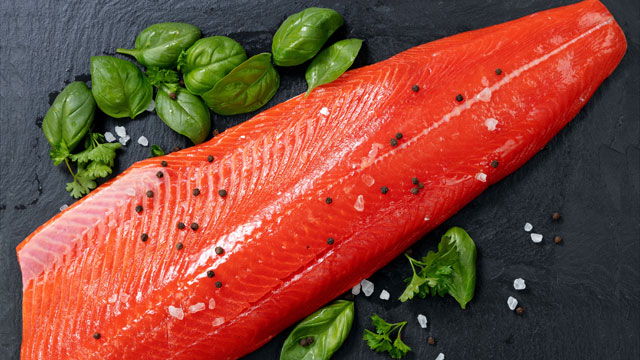Follow us 261.1k
Quick Summary tl;dr
Salmon are a rich source of bioavailable protein, healthy omega-3 fats, and micronutrients like B12, selenium, niacin, choline, and potassium.
The omega-3 fat, DHA, is critical for brain development and function.
Salmon are pink-red because they contain astaxanthin, a powerful antioxidant. Wild Alaskan sockeye salmon have the most astaxanthin. The redder the better.
Salmon is the canonical healthy protein, and for good reason. While we could quibble about whether certain proteins are healthier, and everyone is entitled to their opinion, there is little dispute that salmon is a powerhouse mixture of bioavailable protein, healthy omega-3 fats, and micronutrients.
1. Salmon Has the Most Bioavailable Protein
Salmon, like most fish, have an excellent DIAAS score. DIASS stands for Digestible Indispensable Amino Acid Score, and it’s a protein quality metric that’s replacing the older PDCASS system.
DIASS is a measure of how amino acids — protein’s building blocks — are absorbed in the small intestine. DIASS therefore gives the most accurate known measure of how much protein your body can actually use for healing and muscle building.
For reference, grains and legumes mostly score around 40-60% or less. This does not mean they are low in protein, per se, but that the quality of the protein that is present is poor. By comparison salmon scores 100%, making it definitionally an “excellent quality” protein.
2. Salmon is High in Omega-3 Fats
If you’re a fat-head like us, then you’ll want to check out this longer blog, accompanied by a short video, on omega-3 fats.
But the short of it is as follows: salmon is an incredible source of the long-chain omega-3 fatty acids, EPA and DHA. DHA in particular is critical for the brain. DHA promotes brain development in fetuses and young people, and low levels of DHA are associated with cognitive decline and dementia.( Lauritzen et al, 2016, Crawford et al, 2009)
It’s a little dark, but I like to say that DHA is good for the brain from “womb to tomb.”
In fact, Oxford professor Michael Crawford has hypothesized that the human brain grew in size when inland Africans moved to coastlines and started eating DHA-rich fish. ( Crawford et al, 1999) This migration and change in nutrition fueled a step in our cognitive evolution.
The omega-3 fat, DHA, is important for brain development, function, and preventing cognitive decline. DHA is good for the brain From Womb to Tomb.
Free Download
Trialed & tested for best results
Optimized for nutrition
Never feel hungry
Track all macros including net carbs
Scan products
Create your own meals
Track ketones, blood glucose & lipids
Stay hydrated with water tracking
Track your mood & energy levels
Calculate your ideal fat, protein & carb intake
Set any goal: weight loss, maintenance or weight gain
Your macros update based on your progress
Monitor your macros, water intake, mood & energy
Body weight, body fat and body measurements
Ketones, blood glucose & lipids
Expert articles to help you make informed choices
Guides & free diet plans
New daily content
Complete Keto Diet guide
Integrated shopping basket
Restaurants & guide to eating out
Free Download
3. Salmon is High in Micronutrients
A 5-ounces (142 gram) of sockeye salmon has 300% of the RDA for vitamin B12, 80% for selenium, 80% for niacin, 25% for choline, and more potassium than a banana!
B12 is not only an essential vitamin in its own right, but a series of rat studies ( Rathod et al, 2014, Rathod et at, 2015, Rathod et at, 2016) demonstrated B12 synergizes with DHA! In other words, the animal model suggests that B12 and DHA together are more potent than either is alone at (i) improving the DHA composition of the brain’s cortex and hippocampus, (ii) boosting levels of brain cell growth factors (BDNF and NGF), and (iii) improving memory performance.
Selenium is critical for healthy thyroid function and a healthy metabolism. It’s also a core component of important antioxidant proteins called selenoproteins, a family of enzymes that includes five different glutathione peroxidases and three thioredoxin reductases! ( Labunskyy et al, 2013)
Niacin, also called vitamin B3, is a precursor to coenzymes involved in metabolism, including NAD(H) and NADP(H). ( Veech et al, 2019) NAD(H) is the key to how mitochondria turn food into energy, and NADP(H) is the antioxidant that supports all antioxidants, from the body’s own glutathione to the vitamin C in that cauliflower you might be having alongside your salmon. Check out this Low-Carb Ginger & Lime Grilled Salmon served with cauliflower rice!
Choline is the building block used to make the neurotransmitter, acetylcholine. Along with both B12 and selenium, choline is also important in the methylation cycle, a metabolic process required to properly repair and regulate DNA.
Potassium is, of course, a critical electrolyte, along with sodium and magnesium. Potassium sodium and magnesium are the big three when it comes to low-carb living. Complementing your salmon dinner, some dark chocolate for dessert — another one of the seven New Mediterranean superfoods — is high in magnesium.
Sockeye salmon has 300% of the RDA for vitamin B12, 80% for selenium, 80% for niacin, 25% for choline, and more potassium than a banana!

4. Salmon is High in Astaxanthin
Salmon is packed with protein, healthy fat, and micronutrients. But what really makes salmon a superfood is its unique possession of a pigment called “astaxanthin.” ( Galasso et al, 2018)
Astaxanthin is why salmon are pink-red and it also happens to be a potent antioxidant with some exceptional properties.
Astaxanthin is a powerful antioxidant, with a free radical scavenging capacity ranging from 100 – 6000-fold stronger than Vitamins C, E, or CoQ10.
Astaxanthin is also a multitasker. Using electron dislocation resonance, which is like a chemical forcefield, astaxanthin can simultaneously neutralize up to 20 different free radicals at the same time! Most other antioxidants can’t do this.
And astaxanthin is both water and fat soluble. This means it goes everywhere in the body, every nook and cranny, including outside cells, inside cells, inside membranes and mitochondria, and inside the brain.
With respect to different types of salmon, the astaxanthin hierarchy goes as follows: Sockeye > Coho > Atlantic > Pink > Chinook > Chum. In general, because astaxanthin is the pink-red pigment in salmon, “the redder the better.” ( Ambati et al, 2014)
Astaxanthin in salmon is a powerful antioxidant. Different salmon have different amounts. Sockeye > Coho > Atlantic > Pink > Chinook > Chum.
Do you like this post? Share it with your friends!
Let us know what you think, rate this post!
